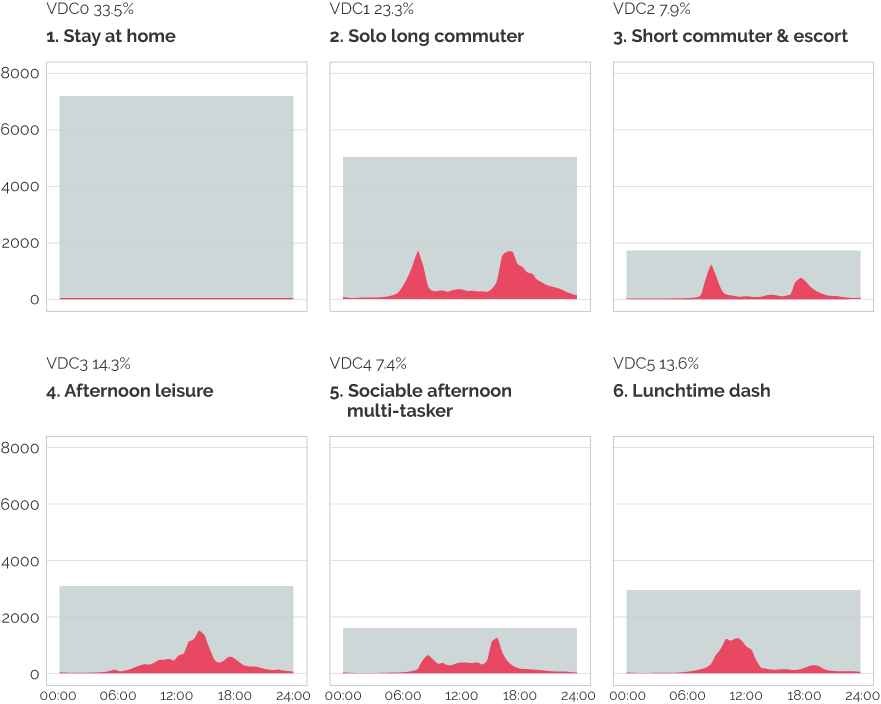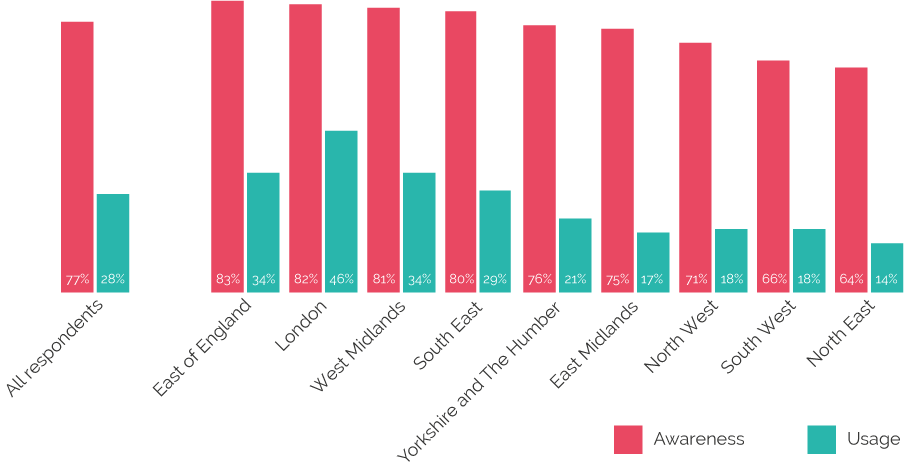In June, the third session explored how people use their vehicles – how often, if they would consider car sharing and the alternatives they have used and are aware of.
Leeds, 18 June 2019
Nexus Building, University of Leeds
Jillian Anable began by presenting her research team’s work on a Day in the Life of the Car. This work is looking at the extent to which there is synchronous use of cars (i.e. exploring what sort of level of asset ownership could service current mobility needs) and whether there are clusters of different profiles of car use (i.e. those that are used intensively or at specific times of day and those that are more static).
The initial work on synchronous car use suggests that the peak volume of the fleet in use at any one time is around 15% in a weekday (Tuesday) morning and evening peak. On Sundays the value is as low as 8%.
The findings on vehicle usage clusters identified six as shown in Figure 1 below. Around a third of vehicles do not move at all during a day (VDC0) compared with 23.4% where there is a “solo long commute” (VDC1). These findings show significant diversity in vehicle usage. The complementarity of vehicle usage profiles suggests that greater asset sharing could be possible. The findings also suggest that a different approach to thinking about when vehicles will be where in order to charge in a more electric future might need to be re-thought (relative to the current assumption of 6pm for an overnight home charge).

Figure 1: Daily Vehicle Usage Clusters (Mattioli et al., 2019)
The work has gone on to consider the ways in which different vehicle day profiles cluster over a week.
The session then explored findings from the Foresight Future of Mobility study on sharing, presented by David Golightly and on sharing in an autonomous future, drawing on a study for the International Transport Forum, by Natasha Merat.
The findings underlined the importance of recognising the diversity in shared mobility systems and the need to understand the particular characteristics of each.
Particular aspects which will matter for sharing in-use are the synchronicity of demand and the extent to which behaviour outside of the specific journey impacts on what is seen to be feasible to someone. Tying back to discussions from Evidence Session 2, sharing systems require human and social capital and it takes time to build up these elements of the systems. It is in the social construction of the systems that issues like trust play out. It is also the case that trust can be lost and systems break down over time if the social capital is not maintained. There is a natural churn in users and also in user needs.
Tracing the impact of sharing platforms can also be difficult – as sharing may start through on-line platforms before moving off-line or into private clusters.
It is, as yet, difficult to interpret how sharing of autonomous vehicles might develop. Most trials to date are in highly controlled environments such as airports or expo parks. The vehicle types tend to be of around an 8 seater style vehicle operating at low speeds. This does not tend to be mirrored in the concept cars which manufacturers show case. It is not clear when sharing in groups is seen to create sufficient surveillance and mutual trust as to be seen as safe. The sizing and design of future fleets which would encourage sharing is still unclear although future work from the Department for Transport will explore this.
The distinction between acceptability and acceptance is important. Something may not appear to be desirable but might, in use, be accepted once there is experience of it or others are using it. This makes the interpretation of questions around what is acceptable or not with respect of sharing difficult.
Three critical elements of acceptance were identified as performance expectation (benefits of using), hedonic motivations (sense of fun) and the degree of support around using the system. System trust was raised as a critical issue for autonomous vehicles but also for sharing more generally. Not enough trust leads to a lack of willingness to use. Too much trust means the user expects the system to do things it is not designed for. Clarity over the safety, reliability and security aspects of sharing in a more automated environment will be necessary to understand what types of sharing will be likely to be accepted.
Helen Bullock and Demelza Birch presented on recent Department for Transport research on the Transport and Technologies Public Attitudes Tracker. The data shows that whilst over three quarters of people are aware of app based taxi or mini-cab services, only around one quarter of people are aware of car clubs. Looking at use, just under 30% have used app based taxi or mini-cab services. However, of Uber users questioned over three quarters had not used a pool service. Only 1% of respondents had used a car club vehicle, compared with 3% for public bike sharing.
Reinforcing evidence from Sessions 1 and 2, the profile of users of app based taxi services is skewed towards younger and middle aged adults and also towards London and much lower in the North (see Figure 2).
As the literature suggests, the perceived safety risk of travelling with strangers is a barrier to 42% of people (49% women and 36% men). The main perceived advantage of sharing is cost savings (67%). However, an average fare reduction of almost £9 on a £20 fare was reported as being necessary to shift to a shared taxi. Discussions questioned how viable such a large reduction would be, particularly in some parts of the country where a £20 fare would cover a large distance.

Figure 2: Regional Variation in use of app-based taxi/private hire
Finally, the Tracker Survey identified that respondents are still very attached to the car as shown in Figure 3 and this cannot be overlooked in thinking about why so little sharing currently happens.

Figure 3: Attitudes to cars (DfT’s Transport and Technology Public Attitudes Tracker, December 2018)
However, discussion also explored how the different questions are asked. Given the profiles of actual vehicle use and the low awareness and use of car clubs for example, it could be possible that current lifestyles could be serviced with lower ownership. This would not necessarily address the feelings of freedom and independence of individualised ownership. However, it was suggested that net zero carbon would mean that sharing could be a necessary and feasible way of servicing a much greater proportion of mobility needs and that desirability and wants may change or need to change.
Overall reflections suggested a need to focus on improving the sharing options that are out there today and to develop the necessary cultures and practices of sharing. There seem to be opportunities to change the model of car ownership given the usage patterns of the assets, but there needs to be a shift in the availability and understanding of alternatives. Asking people about what they prefer today, whilst providing insights, will not be sufficient to design the systems for tomorrow. Some more radical and longer-term pilots might be necessary to test what alternative provision could be desirable and feasible.
The in-built bias of focussing on the commute both as a journey purpose and a main use of cars was exposed by the vehicle usage patterns. Similarly, there is a bias to thinking about the most congested central areas. There are quite big disparities between urban, peri-urban and rural areas and yet most of the discussion is happening around central city spaces where the alternatives are already good.
Presentations
Commission on Travel Demand Shared Mobility Inquiry Evidence Session 3
Sharing inquiry – a week in the life of a car
Human factors in exclusive and shared use in the UK transport system
Human factors, user requirements and user acceptance of Shared Automated Vehicles (SAVs)
DfT evidence on public attitudes to sharing
Attendees
- Professor Greg Marsden, ITS, University of Leeds – Commission Co-Chair
- Professor Jillian Anable, ITS, University of Leeds – Commission Co-Chair
- Jonathan Bray, Urban Transport Group – Commissioner
- Eric Manners, Jacobs
- Nicola Spurling, Lancaster University – Commissioner
- Demelza Birch, Department for Transport
- Helen Bullock, Department for Transport
- Antonia Roberts, ComoUK
- Tracy Savill, Connecting Places Catapult
- Ellie Davies, Committee on Climate Change
- Dr David Golightly, Newcastle University (virtual)
- Professor Natasha Merat, ITS Leeds
- Kate Gifford, West Yorkshire Combined Authority
- Christopher Allwinter, Transport for Greater Manchester
Banner photo credit: Christopher Burns on Unsplash
